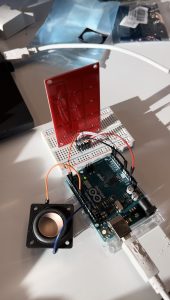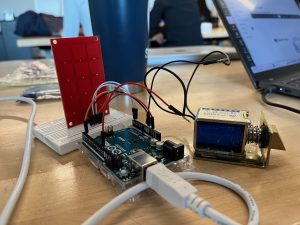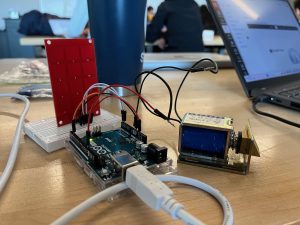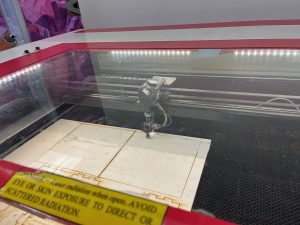- What are the most significant risks that could jeopardize the success of the project? How are these risks being managed? What contingency plans are ready?
Currently, the most significant risk is implementing Bluetooth to connect our system. There is a bit of a learning curve for our team as we do not have any prior experience working with this technology. For example, we have experienced issues with integrating Bluetooth support into our mobile app, which has delayed our progress in this area. We have built buffer time into our project schedule specifically for these kinds of issues.
A smaller but noteworthy issue we are currently working on solving is understanding how the Seeed Studio Xiao microcontroller functions with respect to the door lock components. The starter code for the keypad was written for Arduino, and altering it for the Seeed has so far been unsuccessful. To temporarily get around this issue, we have swapped the Seeed for an Arduino Uno, with plans to switch back once we get to a functional state with the Seeed. If we cannot get the Seeed to work properly, we will permanently switch to an Arduino for the door lock.
- Were any changes made to the existing design of the system (requirements, block diagram, system spec, etc)? Why was this change necessary, what costs does the change incur, and how will these costs be mitigated going forward
As mentioned previously, the door lock microcontroller was temporarily switched to an Arduino Uno due to needing to do more research on how to use the Seeed and getting the lock to a functional state in the meantime. We have not incurred any additional costs and will hopefully be switched back to the Seeed next week.
Global, Cultural, and Environmental Considerations
Please write a paragraph or two describing how the product solution you are designing will meet a specified need…
Part A: … with consideration of global factors. Global factors are world-wide contexts and factors, rather than only local ones. They do not necessarily represent geographic concerns. Global factors do not need to concern every single person in the entire world. Rather, these factors affect people outside of Pittsburgh, or those who are not in an academic environment, or those who are not technologically savvy, etc.
The primary impact this has globally is accessibility, simplicity, and security. This system is approachable to any able-bodied person who wants some sort of security system for a house, apartment, office, or even a room. As long as the user can make simple dance movements with their feet they are capable of using the system. The simplicity of the system is also in the patterns. The patterns are done through movements and encourage an active lifestyle with a secure and complex dancing pattern on the security side that can be easily recognized and created by the user.
This system is not complicated, as smart home systems have become affordable and necessary in a complex and changing world. Having a doormat that can easily hook up to your door and be a unique pin system is very useful. In the end, this also comes down to cost. Many similar systems will cost hundreds of dollars and have a difficult setup, this will cost under $150 for the prototype alone, with a realistic mass production being extremely cheap.
Part B: … with consideration of cultural factors. Cultural factors are encompass the set of beliefs, moral values, traditions, language, and laws (or rules of behavior) held in common by a nation, a community, or other defined group of people.
We have considered the following cultural factors when designing the BeatLock system: beliefs and morals, languages, and symbols.
In terms of beliefs and morals, two main points of discussion are the morals presented in the lyrics of the user’s song choices and religious or cultural groups that disallow dancing. To the first point, we will ensure a sufficiently diverse collection of songs the user can select from for their dance and either an “E” or “clean” marking on the songs to indicate any profanity that users may be morally opposed to listening to or endorsing. In the most conservative case, an instrumental or classical piece will be available in the song selection; this will of course be accompanied by potentially more culturally abrasive songs. To the second point, some religions and sects such as the Quakers do not permit dancing; this is an issue that we do not believe BeatLock needs to cater to, as these groups of people will likely be uninterested in the product.
Due to the quick turnaround for this product, we will only be concerned with English. If there is sufficient time at the end of the semester, we may choose to adapt the app to include a secondary language option.
Although we have elected to only provide the system in English, we want to ensure the symbols used on the mat and lock are universally understood. Basic arrows and foot outlines on the mat as well as lock and unlock icons on the door lock keypad should sufficiently meet this need.
Part C: … with consideration of environmental factors. Environmental factors are concerned with the environment as it relates to living organisms and natural resources.
The BeatLock system has been conceptualized with environmental concerns in mind. In the current era of widespread consumerism, many products are designed to be cheap and delicate, so that they need to be thrown out and replaced often. This increases the amount of product the company can sell. However, it has detrimental effects on the environment, due to the excess trash that ends up in landfills, in addition to the increased water usage and carbon emissions associated with product development and distribution. We have designed BeatLock so that it will be high-quality and durable, because we do not want our users to need to replace their doormat every year. Furthermore, if someone does not want their mat anymore, they can give it away to somebody else, and that person will only need to install the lock. Additionally, we aim to use the most simple electrical components possible, as this will reduce the amount of materials that we use per mat. So, in comparison to many other products created by technology companies, we will have a smaller negative impact on the environment.
**Part A was written by Brooke Rodriguez, Part B was written by Jada Fink, and Part C was written by Zoe Rudnick.









